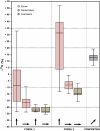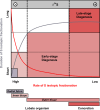Pyrite morphology and sulfur isotopes refine taphonomic models for the 2.1 Ga Francevillian biota, Gabon
- PMID: 40473672
- PMCID: PMC12141565
- DOI: 10.1038/s41598-025-04512-4
Pyrite morphology and sulfur isotopes refine taphonomic models for the 2.1 Ga Francevillian biota, Gabon
Abstract
Pyritization is a key taphonomic process that preserves some of Earth's oldest fossils. It is influenced by various factors such as organic matter type, the availability of iron and sulfur, and sedimentation rates. In this study, we analyzed pyritized biotic and abiotic structures from 2.1 Ga deposits in Gabon's Francevillian Basin, to reconstruct their taphonomic pathway at the micron scale. Using secondary ion mass spectrometry and scanning electron microscopy, we examine sulfur isotope compositions, pyrite morphology and grain size within individual fossils and compare them to abiotic pyritic concretions from the same stratigraphic level. Our results reveal differences in pyrite grain size and sulfur isotope composition between fossils and concretions. More importantly, chemical and morphological variations are observed within individual fossils, likely due to distinct reactive environments for pyrite mineralization, linked to organic matter, sulfate and iron availability during early diagenesis. This remarkable variation in pyrite morphology and δ34S values in the fossilized specimens, indicates that they were compositionally more complex than the substrate that formed the homogeneously pyritized concretions. This well-preserved ecological window represents an exceptional record of the earliest multicellular life forms on Earth.
© 2025. The Author(s).
Conflict of interest statement
Declarations. Competing interests: The authors declare no competing interests.
Figures





Similar articles
-
Sedimentary pyrite sulfur isotope compositions preserve signatures of the surface microbial mat environment in sediments underlying low-oxygen cyanobacterial mats.Geobiology. 2022 Jan;20(1):60-78. doi: 10.1111/gbi.12466. Epub 2021 Jul 31. Geobiology. 2022. PMID: 34331395
-
Nanoscale analysis of pyritized microfossils reveals differential heterotrophic consumption in the ~1.9-Ga Gunflint chert.Proc Natl Acad Sci U S A. 2013 May 14;110(20):8020-4. doi: 10.1073/pnas.1221965110. Epub 2013 Apr 29. Proc Natl Acad Sci U S A. 2013. PMID: 23630257 Free PMC article.
-
Sulphur cycling in a Neoarchaean microbial mat.Geobiology. 2017 May;15(3):353-365. doi: 10.1111/gbi.12227. Epub 2017 Jan 27. Geobiology. 2017. PMID: 28128527 Free PMC article.
-
The role of biology in planetary evolution: cyanobacterial primary production in low-oxygen Proterozoic oceans.Environ Microbiol. 2016 Feb;18(2):325-40. doi: 10.1111/1462-2920.13118. Epub 2015 Dec 21. Environ Microbiol. 2016. PMID: 26549614 Free PMC article. Review.
-
Geological constraints on detecting the earliest life on Earth: a perspective from the Early Archaean (older than 3.7 Gyr) of southwest Greenland.Philos Trans R Soc Lond B Biol Sci. 2006 Jun 29;361(1470):851-67. doi: 10.1098/rstb.2006.1836. Philos Trans R Soc Lond B Biol Sci. 2006. PMID: 16754603 Free PMC article. Review.
References
-
- Briggs, D. E. G. The role of decay and mineralization in the preservation of soft-bodied fossils. Annu. Rev. Earth Planet. Sci.31, 275–301 (2003).
-
- Purnell, M. A., Zhang, M., Jiang, H. & Lai, X. Reconstruction, composition and homology of conodont skeletons: A response to Agematsu et al.. Palaeontology61, 793–796 (2018).
-
- Saleh, F. et al. Insights into soft-part preservation from the early ordovician Fezouata Biota. Earth Sci. Rev.213, 103464 (2021).
-
- Briggs, D. E. G., Kear, A. J., Martill, D. M. & Wilby, P. R. Phosphatization of soft-tissue in experiments and fossils. JGS150, 1035–1038 (1993).
MeSH terms
Substances
Grants and funding
LinkOut - more resources
Full Text Sources
Medical

